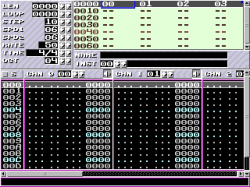I just stumbled upon the Google Chart API and I couldn’t resist playing with it (statistics being a fetish of mine). A few moments later, I came up with some PHP code that uses my stats plugin for WordPress to fetch page views and generates an URL for the Google API (see below for the attached source code).
The main idea behind Google Chart is that the chart is an image and all data for the chart is in the URL. That includes the chart title, size and the data sets. Personally, I think this is a brilliant idea. You can embed the charts anywhere you can use images and best of all, you don’t need to have data anywhere else but in the URL (you don’t even need to duplicate the generated image in your own webspace).
You can also pretty much generate charts by hand if needed.
On the other hand, when using dynamic data fetched from a database, it is a relatively small task to encode the data into the format Google Chart uses. They even provide a Javascript snippet for that (obviously, you might want to do that server-side – see below). Or, you can simply use floating point numbers if you don’t mind long URLs (and I’m not even sure you can always use very long URLs).
For example, below there’s a graph generated from daily visits to this site:

And here is the URL used to get that graph (lines split for convenience):
http://chart.apis.google.com/chart?
chs=400x150&chd=s:NQGHJ&cht=lc&chdl=Page+views
&chxt=x,y&chxl=0:|Mon|Tue|Wed|Thu|Fri|1:|200|500
The above URL has quite Google-like short parameter names but that’s obviously because of technical limitations. The chd parameter is where the data set for the graph is: s:NQGHJ – simple encoding : encoded data.
One interesting aspect arises because of the encoding: you need to fit your data set to use the granularity the encoding has. E.g. when using simple encoding and encoding a data set of 0, 4.7 and 244, you have to normalize and remap the data so the data goes from 0 (character A) to 61 (character 9), not from 0 to 244. That may sound horribly inaccurate but remember, nobody measures the charts with a ruler – they look at the numbers for accurate data. And there are more accurate encodings.
 I like how the charts look slick. A lot of existing libraries and APIs for similar stuff tend to have less aesthetic appeal. Anti-aliasing does not better stats make but it certainly looks more professional. The API also has nice features such as adding arrows and red X’es on a graph (think an arrow with the caption “stock market crash” – after which the graph plummets), the always useful Venn diagrams (see right) and other usual stuff you’d need.
I like how the charts look slick. A lot of existing libraries and APIs for similar stuff tend to have less aesthetic appeal. Anti-aliasing does not better stats make but it certainly looks more professional. The API also has nice features such as adding arrows and red X’es on a graph (think an arrow with the caption “stock market crash” – after which the graph plummets), the always useful Venn diagrams (see right) and other usual stuff you’d need.
Anyway, my original point was that Chart is a cool API, is probably easier to use and faster to install than gnuplot or other chart drawing software, is compatible with any browser able to display images and it’s free for everyone to use (the limit is something like 50 thousand views per user per day – and I guess their policy says nothing against caching the charts on your own site). Check it out.
P.S. This is quite obvious but… I predict that in the future, Google will use the accumulated charts for some kind of statistics search. The charts contain text (label, title) so a Google search result might include relevantly labeled graphs. Which is an interesting scenario, considering the Internet is full of lies, kooks and gullible users.

 I like how the charts look slick. A lot of existing libraries and APIs for similar stuff tend to have less aesthetic appeal. Anti-aliasing does not better stats make but it certainly looks more professional. The API also has nice features such as adding arrows and red X’es on a graph (think an arrow with the caption “stock market crash” – after which the graph plummets), the always useful
I like how the charts look slick. A lot of existing libraries and APIs for similar stuff tend to have less aesthetic appeal. Anti-aliasing does not better stats make but it certainly looks more professional. The API also has nice features such as adding arrows and red X’es on a graph (think an arrow with the caption “stock market crash” – after which the graph plummets), the always useful